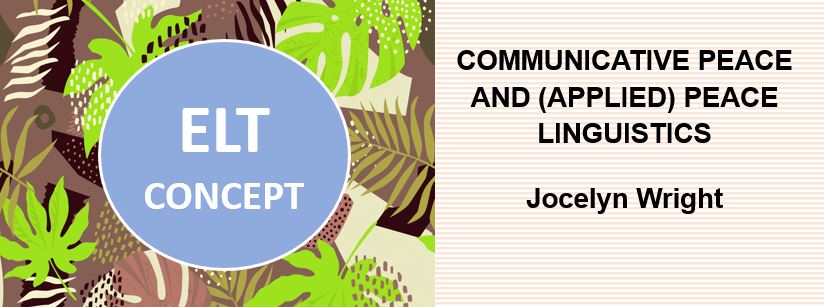ELT Concept #12 – Communicative Peace and (Applied) Peace Linguistics
Jocelyn Wright – 6 July 2021
What is it?
The term ‘communicative peace’ was coined by Brazilian scholar Francisco Gomes de Matos in his 1991 article ‘What the world needs now: Communicative peace’. In 2005, he described this as “a new, thought-and-action-provoking way of humanizing competence” (p. 211). In his view, it was not sufficient to communicate accurately, fluently, and appropriately. He believes we need to communicate constructively and in ways that foster well-being (Gomes de Matos, 2000), and I also agree that this is desirable.
Gomes de Matos’ concept belongs to the important emerging area of ‘peace linguistics’, which was first formally defined by the esteemed British scholar David Crystal in 1999 as
A climate of opinion … in which linguistic principles, methods, findings, and applications were seen as a means of promoting peace and human rights at a global level. The approach emphasizes the value of linguistic diversity and multilingualism … and asserts the need to foster language attitudes which respect the dignity of individual speakers and speech communities. (pp. 254-255)
An early pioneer, Gomes de Matos worked to develop the field, which was extended by his compatriot, sociolinguist Patricia Friedrich in the first decade and which is increasingly attracting others.
(Applied) peace linguistics, as I understand it, is an interdisciplinary field guided by the goal of promoting peace and peacebuilding through systematic study, deliberate teaching, and conscious [1] use of languages spoken, written, and signed.
Why is it important?
Gomes de Matos has long advocated for the intersection between (applied) linguistics and peace and the integration of communicative peace into the notion of communicative competence. Reporting on a plea he wrote in 1993, he states the following:
I argued that as interdisciplinarians committed to describing, explaining, enhancing, and sustaining socially dignifying practices mediated by language, it is incumbent on us to exercise our professional communicative responsibility so as to contribute to universalizing communicative peace, not only as an analytical concept but as a pervasive process characterizing micro and macro social structures. (2000, p. 340)
As this peace linguist goes on to state in the same article, “it is my conviction that human beings’ right to a peaceful and just life should be matched by a corresponding human responsibility to communicate peacefully (2000, p. 341). He, thereby, emphasizes the need for agency to achieve harmony and social justice, two essential elements of peace.
As we know, “one cannot not communicate” (Watzlawick, Beavin, & Jackson, 1967, p. 49). Everything we do involves communication, and communication involves more than language. Thus, whether we consider what we teach (be it a focus on language, skills, content, or projects) or how we teach (from relational aspects such as our interactions to more pedagogical ones, including adopted or adapted methods, tasks, and assessments, and choices of materials and technologies), communication is always involved.
Given that English Language Teaching (ELT) activities are so numerous and varied, the sector is widely influential. As its potential impact is, consequently, not negligible, knowledge about communicative peace in its various instantiations and attempts to study and implement this in diverse ways in our classrooms and communities is immensely important.
Communicative competence that includes a peacebuilding mentality can guide users (including materials developers, teacher educators, and teachers as models and educational leaders and researchers as influencers) to work towards the imperative of promoting peace locally and globally, bottom up and top down.
My Reflection
I came across communicative peace and (applied) peace linguistics rather late, only in 2018. My journey here involved first travelling through the more personal waters of reflective practice and later the social terrains of critical education and critical applied linguistics. After exploring nonviolent communication and landing on peace, I felt filled not only with a greater understanding of myself and my work but a more positive and compelling mission.
Engaging in (let alone, teaching) communicative peace day in and day out is no easy feat. Like language learning, it requires consciousness and a sustained commitment. This humanizing process is, thus, one that would appeal most to those, like me, seeking deeper meaning in their vocations and transformative outcomes. Moreover, while individual contributions are helpful, it is an endeavor that will best be achieved through collective efforts.
To this end, I have launched a Facebook group to connect language scholars and practitioners around the world interested in working together on this collaborative social project. If interested, please contact me (jocelynmnu@yahoo.com) or feel welcome to join our online network: https://www.facebook.com/groups/peacelinguistics
Notes
[1] For Rebecca Oxford (2017), ‘peace consciousness’ involves awareness, attention, intention, and effort in the direction of peace.
References
Crystal. D. (1999). A dictionary of language (2nd ed.). Chicago: The University of Chicago Press.
Gomes de Matos, F. (1991). What the world needs now: Communicative peace. FIPLV World Newsletter, 22(May), 1-2.
Gomes de Matos, F. (2000). Harmonizing and humanizing political discourse: The contribution of peace linguists. Peace and Conflict: Journal of Peace Psychology, 6(4), 339-344.
Gomes de Matos, F. (2005). On communicative peace: Origins, goals, and applications. Journal of Peace Education, 2(2), 210–211.
Oxford, R. (2017). Peace through understanding: Peace activities as innovations in language teacher education. In T. S. Gregersen, & P. D. MacIntyre (Eds.), Innovative practices in language teacher education: Spanning the spectrum from intra- to inter-personal professional development (pp. 125-163). Cham: Springer.
Watzlawick, P., Beavin, J. H., & Jackson, D. D. (1967). Pragmatics of human communication: A study of interactional patterns, pathologies, and paradoxes. New York: W. W. Norton & Company.
ELT Concept #11 – Involvement Load Hypothesis


This is an essential need of the present world. Unfortunately, since many people neither know about this novel concept nor they are skilled in the ways and means of practice, the application of peaceful communication is still not a reality. We need more promotions about Peace Linguistics.